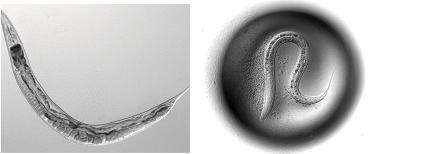The new screening method uses several strains of roundworms. Shown here is the N2 strain of C. elegans. Credit: Mark Lucanic
A new screening approach uses several types of roundworms to identify chemicals that might one day help people stay healthy longer. Researchers will present initial findings from their search for anti-aging compounds at The Allied Genetics Conference, a meeting hosted by the Genetics Society of America.
"There is a key need for pharmaceuticals that can combat Alzheimer's and Huntington's disease, cancer, and other diseases related to aging," said lead author Mark Lucanic, Ph.D., a postdoctoral fellow in the lab of Gordon Lithgow, Ph.D., at the Buck Institute for Research on Aging. "We are trying to identify chemicals or compounds that have potent effects on improving lifespan across multiple organisms because these might have a good chance at turning into future drug leads for treating age-related diseases in humans."
Researchers from the Buck Institute are working with teams led by Patrick Phillip, Ph.D., at the University of Oregon, and Monica Driscoll, Ph.D., at Rutgers University, in a consortium called the Caenorhabditis Intervention Testing Program (CITP), which is funded by the National Institute on Aging. Consortium researchers are using multiple species and strains of the roundworm Caenorhabditis to identify chemical agents that can delay the effects of aging across multiple organisms from diverse genetic backgrounds.
The processes involved in aging are quite complex and are likely influenced by a person's genes. The idea behind CITP is that if scientists can find agents that show effects in organisms with diverse genetic backgrounds, those agents might be more likely to be effective in humans, as well. Since roundworms live only about three weeks, they can be used to screen for chemicals affecting lifespan in a short amount of time.
The Buck Institute researchers used three strains each of the roundworms C. elegans and C. briggsae to test a panel of ten compounds that had previously shown increased longevity in C. elegans or other organisms. "For the chemicals that had been previously studied, most had been shown to expand lifespan in the laboratory adapted N2 strain of C. elegans, so we did not know what they would do in wild strains of C. elegans or in C. briggsae," said Lucanic.
The researchers found that many of the compounds increased longevity in the C. elegans strains while some showed effects only in the N2 C. elegans strain. The compound Thioflavin T, however, lengthened lifespan across all the organisms tested. It was also remarkably potent with at least one strain showing a consistent doubling of lifespan.
Thioflavin T is a commonly used laboratory dye that binds to toxic protein aggregates called amyloid plaques, which are found in the brains of people with Alzheimer's disease. Researchers at the Buck Institute had previously published results showing that Thioflavin T could extend the lifespan of one strain of C. elegans and likely works by helping the organisms maintain proper expression, folding, transport and clearance of proteins.
"We hope that eventually some of the chemicals that we've tested that have promising effects on longevity could be fast tracked for testing in vertebrates," said Lucanic. "If they prove effective there, they might one day form the basis of human drugs that can combat aging and age-related illnesses."
By bringing together multiple institutions to work on similar experiments, the CITP makes for stronger science by allowing researchers to validate each other's work. In a recent analysis, the Buck Institute team found that when looking at results as a whole, the three CITP study sites reproduced each other's data quite well. However, when they looked at individual experiments at any given site, there was relatively high variation from experiment to experiment.
"Our findings show that replication—not just by increasing the total numbers of animals assessed but by repeating experiments that identify an effect—is essential in assigning effectiveness to treatments in lifespan studies," Lucanic said.
Lucanic will present this study on Friday, July 15 from 8:00-8:15 a.m. during the Aging and Cell Death session, Grand Ballroom 8A as part of The Allied Genetics Conference, Orlando World Center Marriott in Orlando, Florida.
Provided by Genetics Society of America





















